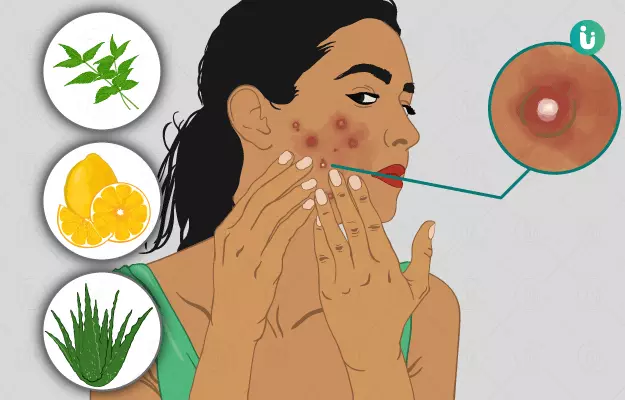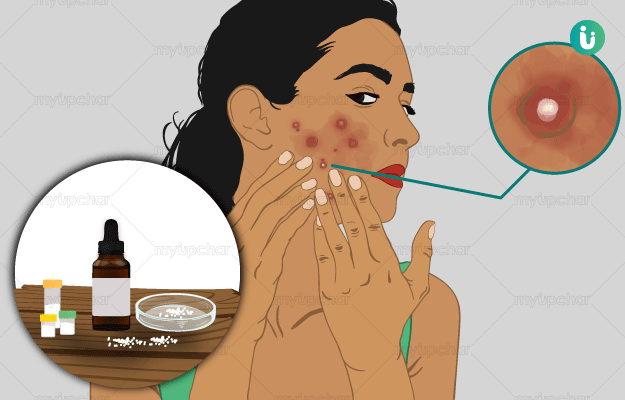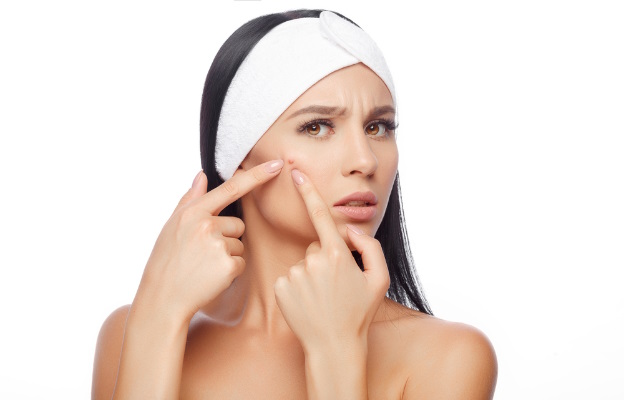Acne is an inflammatory condition of the skin causing outbreaks and spots, which are commonly termed as pimples. These spots are most commonly seen in the area of the face, but can also be found on the neck, upper arms or shoulders. Acne primarily occurs due to the blockage of hair follicles with dead skin or oil and is more common in individuals with oily skin type. Acne can be classified into different types including blackheads, whiteheads, pustules, papule, cysts and nodules, depending on the severity and stage of the lesion.
While it is important to visit your dermatologist to diagnose and manage the condition, a few home remedies can be helpful in the management of recurrent acne. These will assist in improving the condition; however, it is important to check in with your doctor before employing any kind of home remedies, especially for severely infected cases of acne. This article will introduce you to the best of these home remedies and will also share their precautions. So, let’s begin.
- Aloe vera gel for the management of acne
- Green tea for reducing acne
- Turmeric for reducing acne
- Lentils face mask for reducing acne
- Honey for reducing pimples
- Tea tree oil for reducing acne
- Rosemary essential oil for pimples
- Ashwagandha extracts for reducing pimples
Aloe vera gel for the management of acne
Aloe vera is one of the most commonly used remedies for the management of acne and other skin conditions. It has a soothing and cooling effect on your skin, which helps in providing relief from the symptoms of acne as it helps in managing the condition. This can be attributed to the anti-inflammatory and antimicrobial effects of aloe vera gel. Its anti-inflammatory actions yield in symptom control while antimicrobial effects help to suppress the growth of microorganisms. Topical application of aloe vera gel helped to improve mild to moderate acne conditions, as evident by clinical studies. This treatment was found to be undeniably more effective than the conventional treatment of acne. Here is how you can benefit from aloe vera gel:
Ingredients:
- A fresh aloe vera leaf
- A sharp knife
- A container for storage
- Blender
- Bowl
Procedure:
- Take an aloe vera leaf and cut it into 8 inch long sections.
- Cut these 8 inch strips into 2 to 3 long strips.
- Carefully, slide a knife along the bottom edge of the skin so that you yield the maximum amount of gel.
- Repeat on the other side, placing the obtained gel in a box.
- Now, with the help of a blender, grind to form a smooth gel or paste.
- Allow the gel to settle and store it in the refrigerator for a few hours.
- After a few hours, take it off the refrigerator and the gel is ready to use.
- You can use the gel by applying it in the area of the face affected by acne.
- Leave this gel overnight on the areas of spot and remove the next morning with the help of cold water.
- This will help to reduce redness and irritation.
- You can also use aloe vera gel instead of a face cleanser when you wash your face.
Tips:
- You can use this remedy until the symptoms of acne reduce.
- You can safely use it every day.
- If you do not have an aloe vera plant at home, you can purchase some commercially available aloe gels and use it in a similar manner.
Precautions:
-
Be careful with aloe gel and do not apply it around the eyes.
Green tea for reducing acne
Green tea makes for one of the healthiest beverages, but, did you know that it is also effective in the management of acne? This can be credited to the anti-inflammatory and antioxidant effects of this tea, which yield an anti-acne effect. This anti-acne effect is also due to the presence of tannins and flavonoids present in this tea. Additionally, green tea has an antiseptic effect and is thus, also, helpful in the management of other skin conditions and infections. So, green tea can be useful in cases where acne is severely infected. This has also been confirmed by studies on this tea which found that a topical application was effective for the treatment of mild to moderate acne. Favourable results were noted after a duration of 6 weeks, suggesting the use of this agent. Here is how you can use green tea for this benefit:
Ingredients:
- Green tea leaves
- A pan
- A glass of distilled water
- Cotton
Procedure:
- Take a pan and pour in a glass of water, bringing it to a boil.
- Now, pour green tea leaves into this water and sieve.
- The obtained solution can be used as a rinse to clean your face.
- You can also apply some green tea with the help of cotton on infected areas of your face.
Tips:
-
You can use this remedy twice daily until desired results are obtained.
Turmeric for reducing acne
Turmeric is a common kitchen ingredient and one of the most commonly utilised home remedies for a number of conditions. It is particularly used for skin conditions and acne happens to be one of the many conditions it is helpful for. This is possible due to the anti-inflammatory and antimicrobial benefits of the herb, which help in reducing the symptoms of acne and also aids in the prevention of its recurrence. Here is how you can use turmeric for this benefit.
Ingredients:
- Half a teaspoon of turmeric
- Two teaspoons of yoghurt
- A teaspoon of honey
- A bowl
Procedure:
- Mix all ingredients in a bowl and apply it to your face in the form of a mask.
- Leave on until the pack dries and then rinse with water.
Tips:
- Apply this mask on clean and dried skin.
- You can make the use of this remedy biweekly.
Precautions:
-
Make sure to avoid the area of your eyes as you apply the mask.
Lentils face mask for reducing acne
Lentils or daals are an indispensable part of the Indian kitchen. As many benefits this food has for your overall health, it is also great to your skin. Studies have found that it helps in the management of acne when used in the powdered form. This has been credited to the presence of polyphenols in this food, which are responsible for its antioxidant effect. Further, lentils possess anti-inflammatory and antimicrobial effects, which aid in this action. Daals also have an anti-androgen effect and will thus help to regulate hormonal factors responsible for the occurrence of acne, which prevents their appearance. Here is how you can use lentils for this effect.
Ingredients:
- A handful of green lentils
- Blender
- Some water
- Bowl
- A piece of cotton
Procedure:
- Take lentils and put them in the blender to form a fine powder.
- Combine with some water to form a paste and allow it to rest for some time.
- Now, apply this paste to your face with the help of cotton.
- Put it in the form of a mask and rinse off after half an hour.
Tips:
-
You can use this remedy once a week.
Precautions:
-
Make sure to not cover your eyes or get any mix within your eyes.
Honey for reducing pimples
Honey is a known antibacterial agent and is thus utilised for the treatment of a variety of skin conditions. Studies have found that honey inhibits the growth of Propionium acnes, which is the causative agent of acne. Thus, it has been evidenced to be useful in the management of acne. Here is how you can use honey for this benefit:
Ingredients:
- 1 tablespoon of honey
- 1 tablespoon of curd
- A mixing bowl and a spoon
Procedure:
- Pour the ingredients in a bowl and mix thoroughly.
- With the help of cotton or clean fingers, apply this mixture to the skin, especially on the areas prone to acne.
- Leave on for about 10 minutes and then wash away.
Tips:
-
You can use this remedy once a day until satisfactory results are noted.
Precautions:
-
While it is safe to apply honey to the skin for the treatment of acne, ingestion of curd or any other milk products is not advisable as this can worsen acne flare.
Tea tree oil for reducing acne
Tea tree oil is an essential oil, which has several benefits for your skin and is also helpful in the management of acne and skin outbreaks. This is because it has a broad spectrum of antibiotic actions and is thus effective against a range of microorganisms, which could be the causative agents of acne. Further, tea tree oil helps to reduce inflammation and thus relieves the symptoms associated with acne. Over a 3-month period, the use of tea tree oil demonstrated better results as compared to placebo. Here is how you can use tea tree oil for acne:
Ingredients:
- Tea tree oil
- Water
- Cotton swab
Procedure:
- Take a glass of water and add a few drops of tea tree oil to this.
- Mix thoroughly and use this mixture to apply on the acne-affected areas of the skin.
Tips:
-
You can use this remedy once or twice a week until the desired results are obtained.
Precautions:
- It is important that you dilute essential oils before use. Using them in an undiluted form can be irritating to the skin.
- Apply this mixture only in the areas of acne.
Rosemary essential oil for pimples
Other than tea tree oil, rosemary essential oil can also be utilised in a similar manner. Rosemary essential oil is useful since rosemary has been found to have an antibacterial potential against P. acnes. Treatment with rosemary essential oil helped to reduce the size and morphology of P. acnes. Here is how you can use this oil for the management of acne:
Ingredients:
- A glass of water
- Few drops of rosemary essential oil
Procedure:
- Combine the ingredients and mix them with a stirrer.
- Apply them on the affected area of the face with the help of cotton.
Tips:
-
Use this remedy once daily.
Precautions:
-
Make sure that the oil is sufficiently diluted before using it.
Ashwagandha extracts for reducing pimples
Ashwagandha is a commonly available Indian herb, which has a plethora of benefits for human health, which are possible due to the valuable properties of the herb. Due to its antibacterial and anti-inflammatory properties, ashwagandha extracts are helpful in the management of acne and here is how you can utilise them:
Ingredients:
- A bowl of milk
- Half a teaspoon of ashwagandha powder
- A spoon
Procedure:
- Mix ingredients with the help of a spoon to form a lotion.
- Apply this on the affected areas of the face.
- Let it stay for 10 minutes, then rinse off with water.
Tips:
-
You can use this remedy every week.
Precautions:
-
Make sure to check with your Ayurvedic doctor before using ashwagandha in order to avoid any side effects.
References
- John Kraft and Anatoli Freiman. Management of acne. 2011 Apr 19; 183(7): E430–E435. PMID: 21398228
- Hamid Nasri, Mahmoud Bahmani, Najmeh Shahinfard, Atefeh Moradi Nafchi, Shirin Saberianpour and Mahmoud Rafieian Kopaei. Medicinal Plants for the Treatment of Acne Vulgaris: A Review of Recent Evidences. 2015 Nov; 8(11): e25580. PMID: 26862380
- Hamid Nasri, Mahmoud Bahmani, Najmeh Shahinfard, Atefeh Moradi Nafchi, Shirin Saberianpour, and Mahmoud Rafieian Kopaei. [link]. 2015 Nov; 8(11): e25580. PMID: 26862380
- Aghasi M, Golzarand M, Shab-Bidar S, Aminianfar A, Omidian M, Taheri F. Dairy intake and acne development: A meta-analysis of observational studies.. 2019 Jun;38(3):1067-1075. PMID: 29778512
- A.U. Tan, B.J. Schlosser and A.S. Paller. A review of diagnosis and treatment of acne in adult female patients. 2018 Jun; 4(2): 56–71. PMID: 29872679















